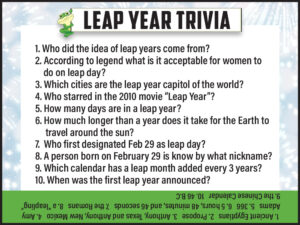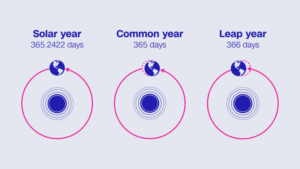 A leap year, occurring every four years, is a fascinating anomaly in our calendar system designed to synchronize the Earth’s revolutions around the sun. This adjustment ensures that our calendar year stays aligned with the astronomical year. But why February?
A leap year, occurring every four years, is a fascinating anomaly in our calendar system designed to synchronize the Earth’s revolutions around the sun. This adjustment ensures that our calendar year stays aligned with the astronomical year. But why February?
 The choice of February for Leap Day traces back to the ancient Romans. They initially had a 355-day calendar and added an extra month, called Mercedonius, every few years to realign with the solar year. Julius Caesar later reformed the calendar, adding days to February to create the leap year system we use today.
The choice of February for Leap Day traces back to the ancient Romans. They initially had a 355-day calendar and added an extra month, called Mercedonius, every few years to realign with the solar year. Julius Caesar later reformed the calendar, adding days to February to create the leap year system we use today.
 Leap Day, falling on February 29th holds significance in various cultures around the world. While it is a day like any other, it carries a sense of novelty and peculiarity.
Leap Day, falling on February 29th holds significance in various cultures around the world. While it is a day like any other, it carries a sense of novelty and peculiarity.
Here are some aspects of Leap Day celebrations, traditions, and superstitions:
- Leap Day Proposals: One of the most famous Leap Day traditions is the idea that women can propose marriage to their significant others. This custom purportedly originated in Ireland during the 5th century when St. Bridget complained to St. Patrick about women having to wait too long for men to propose. In response, St. Patrick designated Leap Day as a time when women could take the initiative.
- Birthday Quirks: Individuals born on February 29th, often called “leaplings” or “leapers,” have a unique relationship with their birthdays. They technically only celebrate their actual birth date every four years, leading to jokes about aging slowly. Some leaplings choose to celebrate on February 28th or March 1st in non-leap years.

- Leap Year Superstitions: Like many unusual occurrences, Leap Day has its share of superstitions. Some believe it’s unlucky to be born on Leap Day, while others see it as a stroke of fortune. In some cultures, it’s considered an auspicious day for beginning new ventures or taking risks.

- Leap Year Celebrations: Various countries and communities celebrate Leap Day with festivals, special events, and themed parties. It’s a time for lighthearted revelry and embracing the quirkiness of the leap year phenomenon.
 Leap Day symbolizes the irregularity and unpredictability of time, reminding us of the complexities inherent in our efforts to measure and organize our lives. It’s a day that encourages us to embrace the unexpected and celebrate the extraordinary in the ordinary rhythm of our existence.
Leap Day symbolizes the irregularity and unpredictability of time, reminding us of the complexities inherent in our efforts to measure and organize our lives. It’s a day that encourages us to embrace the unexpected and celebrate the extraordinary in the ordinary rhythm of our existence.

